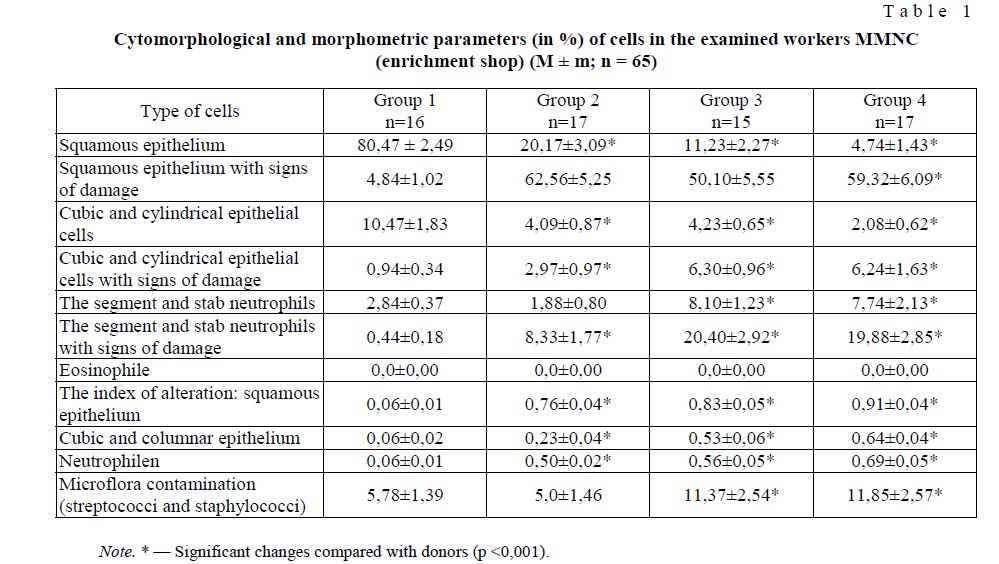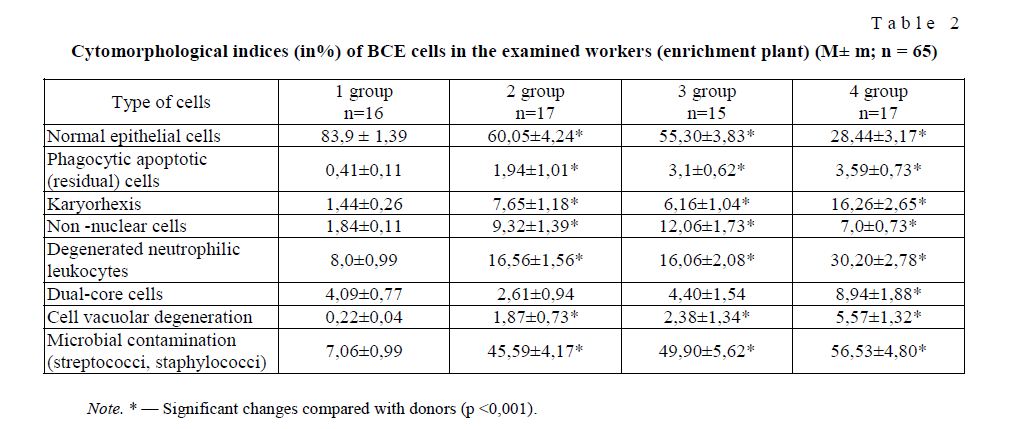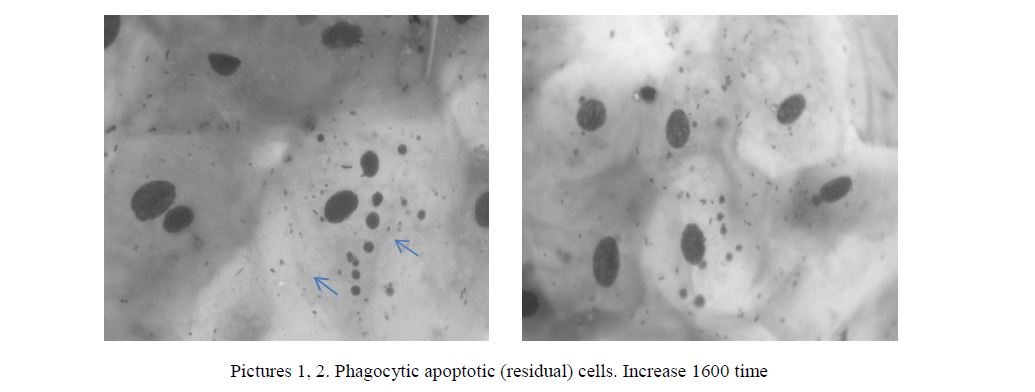Introduction
Industrial dust in the conditions of modern production influences on the respiratory tract and mostly on the upper respiratory ways. Taking into account that between the nasal mucosa, pharynx, larynx and bronchi exist close morphofunctional connection, we can assume the presence of a common pathogenesis of professional diseases of the upper and lower respiratory tract infections. Numerous authors note that industrial dust causing a breach of mucociliary clearance, which in its turn contributes to the penetration of dust into the respiratory system deep laying parts and leads to the development of professional pathology of the respirato- ry system (sub-and atrophic rhinitis, the dust bronchitis, pneumoconiosis and asthma).
The topicality of work is determined by the social significance of the «dust» pathological respiratory tract, deficient study of genetic relationship pathogenesis of chronic respiratory diseases and diseases of broncho-pulmonary system, and the need to develop methods for early detection of chronic nasal cavity dis- eases, buccal cheek epithelium taking into account the work experience in the industry.
These numerous studies show that all of the asbestos fibers chrysotile is the least dangerous and rapidly derived from organism, and amphibole asbestos has a high biological activity and resistance in biological spheres [1].
Issues of occupational pathology of the upper respiratory tracts among workers of asbestos production are devoted to a relatively small number of works. However, the most serious danger is posed by asbestos particles floating in the air and trapped in the respiratory ways that has caused the development of heavy types of silicosis — asbestosis. In this regard, particular importance has the fact that upper respiratory tracts are the «outpost» in the way of air flow and its various parts affected by dust in different degrees [2, 3].
There is the need to study the problems of effects on the organism the industrial factors of chrysotile asbestos production carefully.
The problem of formation of upper respiratory diseases from influence of asbestos dust is still relevant.
In recent years under the screening examinations in the expedition and the experimental conditions in the hygiene practices to detect early forms of upper respiratory tract diseases as a convenient object of study- ing the non-invasive tests — cells of rinotsitogramma and buccal cheeks epithelium are used [4].
Cytological condition of the mucous membranes of the nasal cavity (MMNС) and buccal cheek epithe- lium (BCE) reflects the changing state of the body depending on the pollution of the working environment. Studies have shown the epithelium of the mucous membranes of various degrees of differentiation are in def- inite and stable correlation with each other and vary from different adverse effects both chemical and biolog- ical nature and thus can be considered as a target [5].
Researches showed that dust containing asbestos chemically inert and the mechanism of its effects on the human body is not fundamentally different from that of other types of mineral dust (cement, silica, etc.). Under the small concentrations of asbestos fibers in the air they are mostly trapped in the upper respiratory tract and are excreted naturally (e.g. with sputum). Those fibers that infiltrated the lungs can infiltrate the lung tissue. However they are immediately attacked by phagocytes — cells that perform safety functions in the body. Phagocytes accumulate around the foreign body and dying create around him an aggressive (acid- ic) environment destroying and rejecting fiber. Chrysotile asbestos in these conditions is destroyed and its breakdown products are excreted [6].
Amphibole asbestos, as being acid are not destroyed by phagocytes. But they contain traces of biologi- cally active compounds (compounds of Fe, Co, Ni, and others), which was the reason for the ban of their production and use of the International Convention for Labour Safety under the use of asbestos in 1986 [7, 8].
The aim of work is studying the cytomorphological indices of mucous membranes of the nasal cavity and buccal cheek epithelium of the workers in the asbestos production in the conditions of chrysotile asbes- tos dust depending on the work experience.
Materials and methods of research
65 people were investigated who were divided into 4 groups. In the 1st group consisted of 16 people not contacting with industrial dusts (middle age 32,3 ± 0,95) in the 2nd group — 17 workers (middle age 35,6 ± 1,67, 5–10 years of work experience) in the 3rd group — 15 workers (middle age 38,0 ± 1,93 11–15 years of work experience), the 4th group contains 17 workers (middle age 48,8 ± 1,95, 16–20 years of work experi- ence).
By profession they are electricians on the equipment repairing, regulators, engineers on the shop of en- richment.
Dust chrysotile asbestos refers to a highly fibrogenic containing free silicon dioxide from 20 % to 70 %. MPC dust of chrysotile asbestos is 2,0 mg/m3. Middle changeable concentration of MPC is 0,5 mg/ m3. State of matters in the air in terms of production — an aerosol, class of danger 3, class of labour conditions 3, a feature of the organism to cause is fibrogenic.
With sterile cotton balls by rotational motions from the inner side of the nasal mucosa secretation was taken and thin smears — imprints from the surface of the mucous membranes of the nasal cavity (MMNC) were made on a glass slide. To study the imprint smears from the mucous membrane of cheek, smears were taken with a spatula, laid on a glass slide, smears were dried at room temperature, fixed in May-Grunwald solution. They were painted by the method of Romanovsky-Gimsa. Under the microscoping 300 cells from cytomorphological study were counted. Assessment of the significance of the results was performed by the 1st criteria of Student (p <0,001). Total number of analyzes are 260.
The results of research and discussion
In analyzing the results of MMNС study (on rinotsitogramma) it was found that workers of the 2nd, 3rd and 4th groups compared with donors the decrease in the number of squamous epithelium in 4 times, 7,2 times and 16,9 times, respectively is observed. The number of squamous epithelium with signs of damage increased in all 3 groups in 12,9 times, 10,3 times and 12,2 times, respectively (Table 1).
T a b l e 1
Cytomorphological and morphometric parameters (in %) of cells in the examined workers MMNC (enrichment shop) (M ± m; n = 65)

Number of cubic and cylindrical epithelial cells was reduced by 2,6 times, 2,5 times and 5 times, and with signs of damage to the same cells were increased in all 3 groups of investigated workers in 3,1 times, 6,7 times and 6,6 times respectively. Number of segments and stab neutrophiles was increased in the 3rd and 4th group in 2,8 times and 2,7 times, and with the signs of damage (vacuolated and destructive) was in- creased in the 3 groups in the18,9 times, 46,3 times and 45,2 times, respectively (p <0,001).
The index of alteration of the squamous epithelium was also increased in all three observed groups in 12,6 times, 13,8 times and 15,2 times, cubic and columnar epithelium in 3,8 times, 8,8 times and in 10,6, neutrophiles in 8,3 times, 9,3 times and in 11,5 times, respectively, compared with donors.
The increase in the number of microorganisms was mentioned (streptococci and staphylococci) at the third working and Group 4, on average in 2 times.
Our results showed that the impact of production factors in the upper respiratory ways dystrophic pro- cesses of varying degrees of severity develop: 16 donors’ (group 1) MMNC state among 15 (93,7 %) has no change, 1 observed person (6,3 %) had catarrhal rhinitis.
In group 2 among 4 workers (23,53 %) — catarrhal rhinitis, in 13 (76,47 %) — chronic atrophic rhini- tis.In the third group, six workers (40 %) — catarrhal rhinitis in 9 (60 %) — chronic atrophic rhinitis. In the 4th group in 4 (23,53 %) — catarrhal rhinitis, in 13 (76,47 %), chronic atrophic rhinitis.
These results are consistent with published data. Coming into the body harmful industrial substances cause general toxic action in the first polymorphic MMNC changes. The largest changes are observed in acute and chronic rhinitis. Our observations showed that the workers decreased cleaning ability of the epithe- lium of the upper respiratory tract infections. There is increasing pressure on phagocytic cells. Overloaded with dust and the metabolites they are not functionally active and able to settle in the respiratory ways epi- thelium. Part of the dust penetrates to the basal layer, which is probably one of the triggers of early altera- tions in the flat, cubic and cylindrical epithelium, and leukocytes neygrofilnyh; violation of their functional properties with increasing length of service, significantly increases inhibition of transport function of the mucociliary clearance and acid — base balance.
In parallel, cytological status of buccal cheek cells was investigated in the same groups of workers. Under and buccal cheek epithelium (BCE) cells cytomorphological evaluation among workers of the 2nd, 3rd and 4th groups were found the normal epithelial cells decrease by 38 %, 52 %, and in 2,9 times compared with donors (Table 2).
Observed increase in phagocytic apoptotic (residual) cells in group 2
(Pictures 1, 2), 4,7 times in the third group, 7,6 times in the 4th group, 8,7 times, with signs karyorhexis in 5,3 times, 4,3 times and in 11,3 per cent. The number of nuclear-free cells increased among the workers in Group 2 5 times, the third group by 6,5 times and the 4th group is 3,7 times the number of degenerated neu- trophils increased in the 2nd group of workers is 2,1 times in the third group of 2-fold and 4-th group by 3,7 times. In the 4th group the increase in the number of cells in the dual-core 2,2 times was observed. In the 3 groups (2nd, 3rd and 4th) the increased cell vacuolar degeneration in 8,5 times, 10,5 times and 25,3 times was observed. There is increased microbial contamination (streptococci and staphylococci) in 6,5 times, 7 times and 8 times compared with donors (Table 2).
T a b l e 2
Cytomorphological indices (in%) of BCE cells in the examined workers (enrichment plant) (M± m; n = 65)


Pictures 1, 2. Phagocytic apoptotic (residual) cells. Increase 1600 time
As shown by our study, and buccal cheek epithelium (BCE) cytological status of the workers (of en- richment plant) is intended to change of the barrier properties of the epithelial layer. Increased phagocytic apoptotic (residual) cells in the epithelial cells indicate the effects of toxic factors of industrial environment on the organism of the workers. Buccal epithelial cells are sensitive to various exogenous and endogenous ecological factors impact, which affects the functional changes in cells, where there are various violations of local importance.
Thus, summing up the described research we can note that the enrichment shop workers’ the state MMNC and BCE with varying work experience have established that prolonged exposure to dust leads to a violation of a protective-adaptive mechanisms of the respiratory ways, the severity of which depends on the duration of exposure to dust factors and individual characteristics of the organism. As shown by our study buccal epithelial cells are an indicator of changes in epithelial differentiation, detected cytomorphological (size and number of inclusions in the cytoplasm and signs of changes in the nucleus), which are used for screening health assessment of workers and workers in hazardous industrial environments factors.
Conclusions
- Depending on the work experience with chrysotile asbestos dust on floor at the shop enrichment workers’ cytomorphological MMNC state significantly changed according to the number of degenerated epi- thelial cells, cubic, cylindrical, and neutrophils as well as a high index of alteration in these
- The nature of degenerative changes in the mucous membranes of the upper respiratory tract (catarrh- al, chronic atrophic rhinitis) depends on the duration of productive work It was noted under the professional experience after 5–10 years there are catarrhal changes in the mucous epithelium of the nose, and after 10 to 20 years mainly dominated by the sub-processes and atrophic.
- Violations of the functional state of MMNC and BCE cells accompanied by clinical manifestations, but they are often preceded by a decrease in local immunity, which is a major risk factor in the development of professional diseases of the upper respiratory
References
- Izmerov F. Health of able-bodied population of Russia // Medicine of work and industrial ecology. — 2005. — № 11. — P. 3–9.
- Tulebaev R.K. Scientific researches and innovative workings out on problems of a respiratory pathology in Republic Kazakhstan//Materials 2 National congresses of regions of Kazakhstan and the International conference young otolaryngologists «Pathologies of a respiratory path». — Astana — Shymkent, 2005. — P. 5 — 11.
- Piskunov Z., Zavjalov F.N., Yerofeev L.N. Research mucosiliar transport system of a mucous membrane of a nose at healthy faces // Russian rhinology. — 1995. — № 3–4. — P. 60–62.
- Kulkybaev G.A. Work medicine in Kazakhstan // Medicine of work and industrial ecology, 2003. — № 10. — P. 2–8.
- Bazelyuk T. Morfometrichesky and cytochemical tests at the workers contacting with dust gas by mixes // Methodical recommendations. — Karaganda, 1994. — 21 p.
- Beljaeva N., Sycheva L.T. et al. The estimation of the cytologic status of a mucous membrane of a nose and a mouth at the person // Methodical recommendations. — М., 2005. — 37 p.
- Husainov I.S., Varvuleva I.J., Kazhina N.A. Estimation of cytologic indicators buccal epithelium for diagnostics of a functional condition of the person // Clinical laboratory diagnostics. — 1997. — № 3. — P. 10–12.
- Kutepov N., Beljaeva N.N. et al. The estimation of the cytologic status of a cavity of a nose and a mouth // Hygiene and sanitary. — 1998. — № 4. — P. 54–57.